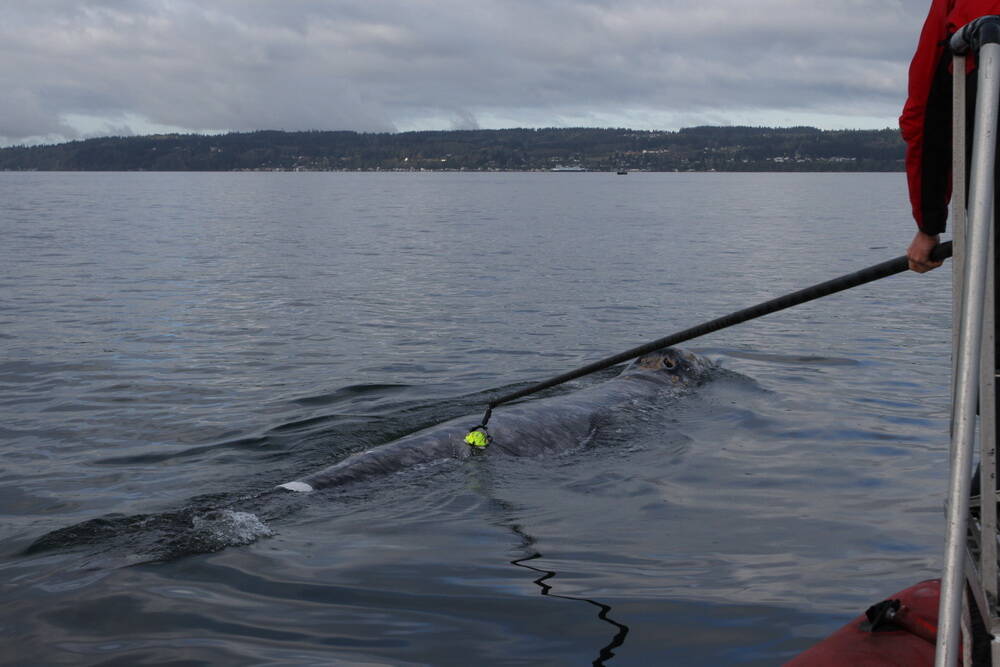The annual arrival of the Sounders continues to be a symbol of resilience for the Eastern North Pacific gray whale population as a whole.
This week, the Whidbey-based Orca Network and the Cascadia Research Collective in Olympia announced the return of the North Puget Sound Gray Whales, a group of approximately 20 cetaceans that come to the area primarily to feed.
Gray whales have been experiencing an unusual mortality event since 2019, which may explain why more and more have been venturing into Puget Sound in search of prey.
“In periods where the overall gray whale population is facing higher mortality and nutritional stress, those have been the time periods that we’ve seen Sounders gray whales expand,” said John Calambokidis of Cascadia Research Collective.
According to a joint press release from the two nonprofit organizations, at least one gray whale was documented feeding around the Snohomish River delta as early as Jan. 12. To date, a total of four Sounders have returned, including Little Patch and Stardust.
For a gray whale to be considered part of the Sounders, it has to return to the area for more than one year in order to be counted.
“So there’s even the potential that as whales arrive this year, this will be their second year and we’ll add it to the tally,” Calambokidis said.
Eastern North Pacific gray whales spend this time of year migrating north from the waters of Baja California to Alaska. A select few Sounders have found a tasty place to eat on that journey, although at least one whale named Tahoma has been documented spending the entire year feeding around the Whidbey Basin.
Howard Garrett of Orca Network said the Sounders take advantage of unique feeding conditions near Penn Cove and Skagit Bay. The Skagit, Snohomish and Swinomish rivers bring in nutrient-rich mud that forms the tidal flats where the whales excavate ghost shrimp in great numbers.
“It works for them,” Garrett said. “They’ve found the secret of survival, and it’s that unique geographical combination of the effects on the east side of Whidbey Island.”
Last year, many of the Sounders received unique names. Some have had names for longer than others, such as Shackleton and Earhart, the pair that have been spotted in Puget Sound since 1990.
“They stay together, which is a complete aberration, because gray whales are not known to be social,” Garrett said of the couple.
Maximum lifespan is unknown, but it is expected to be between 50 and 70 years.
More and more is steadily being learned about the gentle giants over the years. Orca Network joined Cascadia Research Collective in monitoring the Sounders starting in 2001. The two organizations recently released an updated photo identification guide, which can be purchased on the Orca Network website for $25.
Cascadia Research Collective received a $150,000 grant from the National Estuary Program to gather more data about the Sounders, which will include the use of aerial photographs and sensory tags.
Over the past four years, Cascadia Research Collective has partnered with Sealife Response, Rehab, and Research – also known as SR3 – to take high resolution photographs from drones. These vertical images have helped researchers monitor the body condition of the Sounders.
The organization has also been attaching multi-sensor tags with video-recording capabilities to the Sounders. Through these efforts, Cascadia Research Collective has learned more about their underwater actions.
“It showed us that especially during non-feeding periods, these whales are highly social, interacting, making frequent body contact with each other in ways that we were a little bit aware of from their surface behavior, but their underwater behavior revealed even more than we realized,” Calambokidis said.
A batch of new tags will be deployed this April with the use of suction cups. The tags will differ from years past because they will also record acoustics, which will help researchers more precisely measure the exact food intake of a Sounder.
The Sounders typically depart in May, with some choosing to stick around until June.
“The Sounders’ research has been part of a number of studies that have shown gray whales to be far more flexible in the prey they choose, and adaptive to seeking out, finding and then exploiting new prey in new areas,” Calambokidis said.
Sightings can be reported to sightings@orcanetwork.org, or via orcanetwork.org/report-sightings. Because of their slow-moving nature, gray whales can be prone to ship strikes. All vessels should slow to under 7 knots and keep a distance of at least 100 yards from a gray whale.



